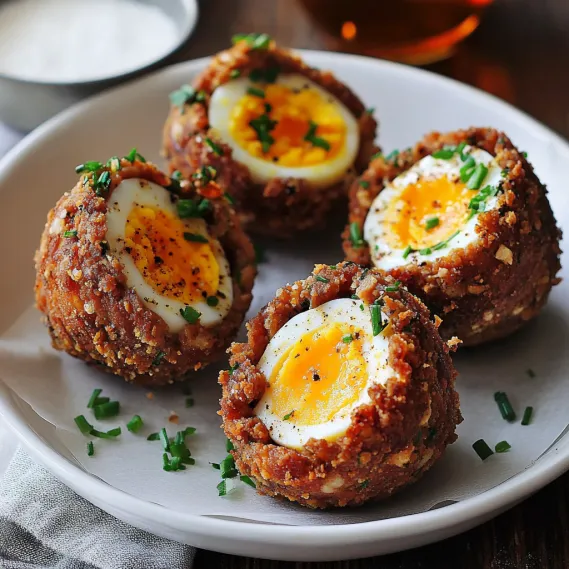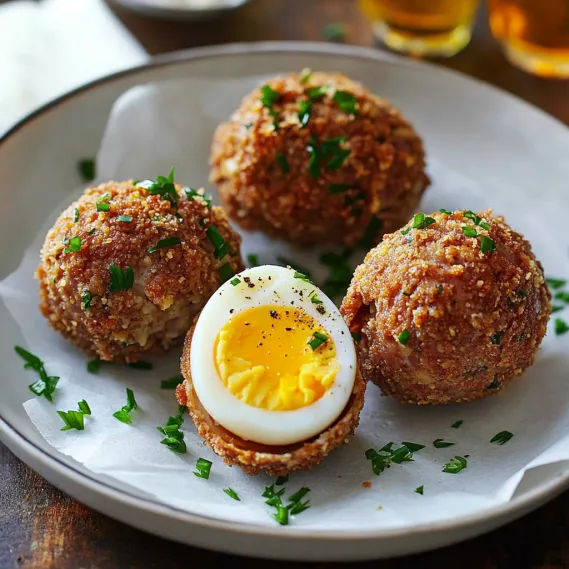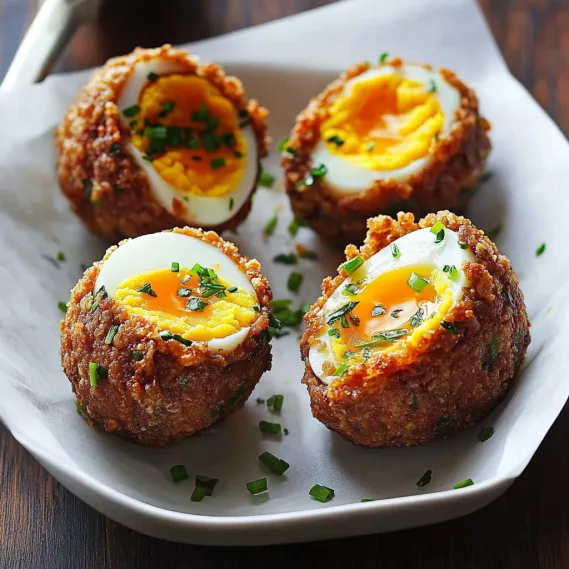 Pin it
Pin it
When you sink your teeth into a hot, fresh Scotch Egg, you'll feel all the textures work together - that nice crunch from golden panko breaks into juicy, herb-packed sausage meat, and finally reveals the hidden gem: that perfectly done egg with its gooey, jammy center.
I brought these to a family get-together last month, and my picky nephew who normally only eats chicken nuggets wolfed down two of them back-to-back. What's the trick? It's all about giving each part attention, especially getting that soft-boiled egg just right to create that amazing moment when you cut it open.
Key Ingredients and Smart Shopping Advice
- Eggs: Go for large, fresh ones for best results. Funny enough, eggs about a week old actually peel better after boiling than super fresh ones.
- Breakfast Sausage: Pick good quality pork sausage with bits of herbs you can see and enough fat to keep things tasty.
- Panko Breadcrumbs: These Japanese breadcrumbs give you a much lighter, crunchier coating than normal breadcrumbs.
- Fresh Herbs: The chives and parsley aren't just for show - they really perk up the sausage mix and add tons of flavor.
- English Mustard: Gives a nice kick and extra depth to your sausage. If you can't find it, Dijon works fine too.
I've learned that your sausage quality really changes how good these turn out. When I can, I buy mine from a local meat shop where I know it's got just the right mix of meat, fat, and seasoning to make these taste amazing.
Step-by-Step Cooking Guide
- Step 1: Cook Your Eggs Just Right
- Get a medium pot with enough cold water to cover 4 large eggs by about an inch. Bring it to a good boil, turn down the heat a bit, and time it for exactly 6 minutes for runny yolks or 7 minutes if you want them a bit firmer. Right away, dump them in ice water for 10 minutes to stop them cooking more, then carefully peel them under running water.
- Step 2: Mix Up Your Tasty Sausage Blend
- In a bowl, mix 1 pound of breakfast sausage with 2 tablespoons each of finely chopped fresh chives and parsley. Throw in 1 tablespoon of English mustard, ¼ teaspoon of freshly grated nutmeg, ½ teaspoon of salt, and ¼ teaspoon of black pepper. Mix it all together with your hands, but don't squish it too much.
- Step 3: Get Your Coating Station Ready
- Set up three shallow dishes in a row: first one with ½ cup flour mixed with a pinch of salt; second with 2 eggs beaten with 1 tablespoon of water; third with 2 cups of panko breadcrumbs. Keep one hand for dry stuff and one for wet stuff so you don't make a mess.
- Step 4: Learn the Wrapping Method
- Split your sausage mix into 4 equal parts. With slightly wet hands, flatten each piece into an oval about ¼-inch thick. Put a peeled egg in the middle of each oval, then carefully wrap the sausage around it, smoothing the edges and pinching any gaps closed.
- Step 5: Do the Double Coating
- Take one wrapped egg at a time and roll it in the flour first, shake off the extra, then dip it in beaten egg, let the extra drip off, and finally roll in panko crumbs, pressing gently so they stick well.
 Pin it
Pin it
My first try with this recipe got me worried about the wrapping part. After a few wonky-looking attempts, I figured out that simple folds work fine - they taste just as good no matter how they look. Now my kids join in with the folding, making their own weird shapes that have become kind of a family thing.
How To Achieve Amazing Texture
What makes these cookies special is how they have different textures - crunchy bottoms with soft, flavorful fillings. I've found that managing moisture is everything. First, you gotta squeeze that salted cabbage really well to get rid of water that would make things soggy. Then, the cornstarch doesn't just hold stuff together, it soaks up any leftover moisture too. Last, the cooking method - fry, then steam, then fry again - gives you that awesome crispy bottom while making sure the filling cooks all the way through.
 Pin it
Pin it
Prep Ahead For Easy Entertaining
The best thing about this recipe is how you can do it ahead of time when you've got people coming over. I often make these in stages: shape and freeze the balls up to a month early, coat them the day before (keeping them covered in the fridge), and just bake them when guests are about to arrive. The smell of these baking fills your house with an amazing aroma that gets everyone hungry. For bigger parties, I make two batches, keeping the second batch warm in a low oven until we need them.
New Ways To Use Leftovers
If you somehow end up with extra Scotch eggs (which hardly ever happens at my place!), you can turn them into completely different meals. Break them up into scrambled eggs for a fancy breakfast hash, or cut them up and toss into a simple green salad with spicy dressing for lunch. My favorite trick is to cut them in half and put them on top of creamy grits, making a hearty breakfast that uses up yesterday's leftovers.
 Pin it
Pin it
Smart Cooking Tricks
- Let the balls cool down for 5 minutes after baking before you serve them - this helps everything inside set up for the perfect bite
- Want more flavor? Add a teaspoon of smoked paprika to your panko mix
- Can't find Scotch eggs nearby? Order online from good places like Bourgeois Meat Market or The Best Stop
- Put out different dips - try spicy remoulade and cool ranch along with the Louisiana sauce
- To make them look fancy for a party, arrange them on a plate with sprinkles of chopped parsley, purple cabbage, and yellow bell pepper to show the traditional green, purple, and gold colors
Frequently Asked Questions
- → Is baking an option instead of frying for Scotch eggs?
- It sure is! Baking is possible, though it may not deliver that same ultra-crispy finish. Set your oven to 200°C (400°F) and place the eggs on a greased baking sheet. A light oil spray or brushing helps too. Leave them in the oven for 25-30 minutes, turning them midway, until the sausage is fully done (at least 63°C or 145°F inside) and the outside is golden.
- → What type of sausage works for Scotch eggs?
- The choice is yours! Traditional versions use plain pork sausage, but breakfast sausages, already seasoned, are a handy choice. You can also try chorizo, Italian sausage, or lighter options like turkey. Taste and adjust the seasoning depending on what you pick.
- → Can these be prepped ahead for a gathering?
- Yep! Assemble them up to two days in advance and chill them in the fridge. They can be enjoyed cold at a picnic or reheated in a 175°C (350°F) oven for 10-15 minutes until warm. Just don’t overdo it, or the eggs might turn dry.
- → How can I nail the soft, gooey egg yolk?
- Timing’s everything here! Start by taking cold eggs straight from the fridge. Drop them into cool water, and let them cook precisely 4 minutes after boiling begins. Quickly dunk them into an ice bath to stop cooking. You'll get a set white and a dreamy, tender yolk.
- → What pairs well with Scotch eggs?
- These bites go wonderfully with different sides. Dijon mustard or French cornichons make a great dip, or serve them with pommes frites (chips) for a meal. You could also plate them with a crisp green salad or enjoy them with pickled veggies and a baguette for a classic Ploughman-style pairing.
- → Why is the sausage splitting while cooking?
- There might be a few reasons. 1) The sausage layer could be too thin – aim for a consistent thickness, 2) Make sure all seams are tightly sealed before cooking, 3) Keep frying oil temp steady at 165°C (325°F), and 4) Avoid flipping too soon – let a crust set to keep things together.
